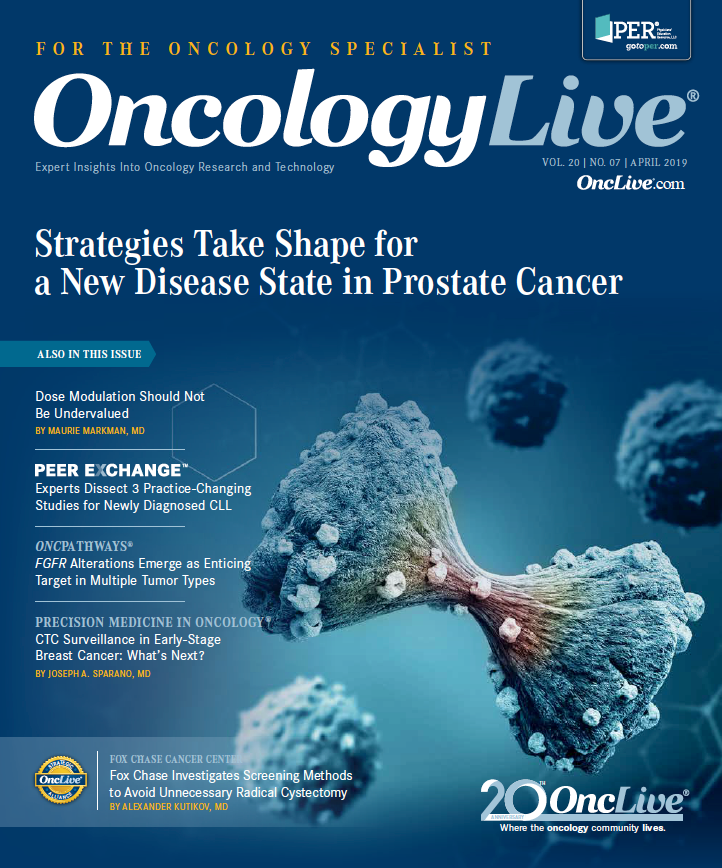Tumor Mutational Burden Poses Challenges as Immunotherapy Biomarker
Although TMB is associated with responses to checkpoint inhibitor therapy, more research is needed to better understand how TMB interacts with other genomic correlates of the immune cycle before the biomarker can be incorporated into clinical practice.
Natalie Vokes, MD, MPhil

Natalie Vokes, MD, MPhil
Although tumor mutational burden(TMB) is associated with responses to checkpoint inhibitor therapy, more research is needed to better understand how TMB interacts with other genomic correlates of the immune cycle before the biomarker can be incorporated into clinical practice, according to Natalie Vokes, MD, MPhil.
TMB was one of the first identified correlates of response to immune checkpoint inhibitors, Vokes noted during a presentation at the 2019 American Society of Clinical Oncology—Society for Immunotherapy of Cancer Clinical Immuno-Oncology Symposium.1 As calculated by large nextgeneration sequencing (NGS) panels, TMB is higher in responders, an association that has been confirmed across multiple therapeutic contexts and multiple disease types.
There are several challenges with employing TMB, said Vokes, a medical oncology fellow at the Dana-Farber Cancer Institute in Boston, Massachusetts.
“There is substantial overlap between the tumor mutation burden values and responders compared with nonresponders, raising questions about how best to use TMB to actually discriminate between these 2 groups,” she said. “Additionally, the growing body of research on this topic has generated a fair amount of heterogeneity. The different sequencing platforms and modalities generate different TMB values, and it’s unclear how the TMB values and the thresholds associated with them from these different tests actually relate.”
To better understand the relationships between the TMB quantification methods and TMB thresholds of response, Vokes’ team assembled 4 real-world cohorts consisting of patients with non—small cell lung cancer who had undergone genetic sequencing by either the Dana-Farber, Memorial Sloan Kettering Cancer Center (MSK), or FoundationOne targeted NGS panels and whole-exome sequencing data from The Cancer Genome Atlas. Two subcohorts of patients whose genomes had been sequenced by either the Dana-Farber OncoPanel or the MSK-IMPACT panel for whom outcomes data were available were also identified.
The distribution of TMB values across the tests was found to differ when plotted linearly. However, applying a normalizing transformation to the distributions and standardizing them into TMB z scores produced a much closer fit between the TMB distributions and the different tests.
In both the Dana-Farber (n = 272) and MSK (n = 227) cohorts, patients who achieved complete or partial responses and those with durable clinical benefit had higher TMB values than did nonresponders. Standardizing TMB values from the 2 cohorts into z scores preserved the relationship between TMB and response to immune checkpoint inhibition.
An analysis of response according to TMB thresholds using a joint cohort (n = 499) of the 2 clinically independent cohorts found the highest rates of durable clinical benefit with the highest TMB values and the lowest rates of durable clinical benefit with the lowest TMB values. Within TMB deciles, however, variability in response was found, “suggesting that part of what we’re doing with these TMB thresholds is enriching for the highest TMB responders,” said Vokes.
To more formally quantify how well TMB discriminates between responders and nonresponders, a receiver operator characteristic analysis was performed, and the optimal TMB threshold was associated with a sensitivity and specificity of only about 60%. “Application of this threshold would have led to 30% of patients being treated without response and failing to treat 12% of patients who would have responded,” Vokes said. Using other TMB z score cutoff points again demonstrated a trade-off in over- versus undertreatment.
Genomic Correlates
The findings suggest that the relationship between TMB and outcomes to immune checkpoint therapy is complicated. TMB is likely not associated with response in a vacuum, Vokes said. Rather, it interacts with other features.In addition to TMB, looking within the tumor microenvironment may also lead to identification of correlates of response. Cancers with high tumor infiltrate and high expression of cytokines and enzymes involved in the tumor immunity cycle represent “hot,” or T cell—inflamed, tumors that appear to be more amenable to checkpoint inhibitor therapy, said Vokes.
“Conversely, cancer cells that evade immune detection or manage to prevent the infiltration of T cells into the tumor microenvironment are classified as ‘cold,’ or T cell—noninflamed, tumors, and these may be less amenable to therapy,” Vokes added. Activation of oncogenic signaling through the mitogen-activated protein kinase, Wnt/β-catenin, and STK11/LKB1 pathways, and loss of phosphatase and tensin homolog (PTEN), may contribute to immune checkpoint therapy resistance by leading to T-cell exclusion.
The features that seem to correlate with response, in addition to TMB, include mutations in DNA repair enzymes as well as expression signatures of interferon-γ signaling or PD-L1, all of which likely associate with the T cell— inflamed environment.
“While this is an attractive way of making sense of these growing data, there’s still a lot that we don’t understand,” said Vokes. “Many of the studies come from small cohorts, and they identify rare events that aren’t confirmed in subsequent cohorts, and we have yet to understand how to integrate these different findings. Going forward, we need to better understand both the relevant biology that contributes to response and how to integrate multiple different genomic correlates of response into better prognostication.”
Her team is aggregating data sets in an attempt to build larger immunotherapy-treated cohorts to both improve the power to validate previously identified findings and identify new pathways involved. In aggregating 249 whole-exome sequencing tumors across different cancer types, they were able to recapitulate the association between PTEN loss and resistance to immunotherapy and identify an association between cell cycle signaling and response.2 Even in this large cohort, many of the findings were statistically underpowered. A power simulation revealed that for the events that poorly discriminate between responders and nonresponders, sample sizes in the hundreds and potentially up to the thousands would be needed, Vokes said.
Other markers of the inflamed tumor microenvironment, such as the T cell—inflamed gene expression profile, may also interact with TMB to help distinguish those patients who are most and least likely to respond.
Multivariate models that incorporate clinical variables (eg, smoking status, PD-L1, and histology) and integrate multiple transcriptomic and genomic features are also being assessed to improve response prediction, 3 Vokes said.
References
- Vokes N. Genomic correlates of response to immune checkpoint blockade. Presented at: 2019 American Society of Clinical Oncology— Society for Immunotherapy of Cancer Clinical Immuno-Oncology Symposium; February 28-March 2, 2019; San Francisco, CA. meetinglibrary.asco.org/record/169276/slide.
- Miao D, Margolis CA, Vokes NI, et al. Genomic correlates of response to immune checkpoint blockade in microsatellite- stable solid tumors. Nat Genet. 2018;50(9):1271-1281. doi: 10.1038/s41588-018-0200-2.
- Hellmann MD, Nathanson T, Rizvi H, et al. Genomic features of response to combination immunotherapy in patients with advanced non-small-cell lung cancer. Cancer Cell. 2018;33(5):843-852.e4. doi: 10.1016/j.ccell.2018.03.018.




